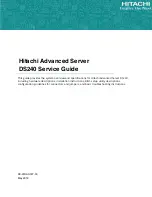
The size of a logical drive is determined by several
factors, but the size must be divisible by the number
of data drives in the array. A logical drive in an array
can be any size you choose within the size limitations
of the array. Consider the following examples:
Example 1. The array consists of three 1 GB
drives.
2
You assign RAID level 0, which uses all
the drives in the array with no redundant or
parity storage; then, you type
1ððð.
The
number 999 will appear in the Size (MB) field
because it is the number closest to and lower
than 1000 that is divisible by 3.
Example 2. The array consists of three 1 GB
drives. You assign RAID level 1, which provides
disk mirroring and stripes data across all drives
in the array. Because the data is mirrored, the
capacity of the logical drive is 50% of the
physical capacity of the hard disk drives grouped
in the array. If you type
1ððð,
the number 999
will appear in the Size (MB) field. The physical
capacity used is 2000 MB, twice that of the
logical drive size. The number that is closest to
and lower than 2000 that is divisible by 3 is
1998. The logical drive size is 999 MB, which is
50% of the physical capacity.
Example 3. The array consists of three 1 GB
drives and you assign RAID level 5. Data is
striped across all three drives in the array, but
the space equivalent to that of one drive is used
for redundant storage. Therefore, if you type
1ððð,
the number 1000 remains in the Size (MB)
field because it is divisible by 2 (drives), which is
the space available for data. The physical
capacity used is 1500 MB.
4. Type the size, in megabytes, that you want for the
logical drive; then, press Enter.
5. When the Confirm pop-up window appears, select
Yes; then, press Enter.
Information about the new logical drive appears in the
Logical Drive list. If you did not use all of the
available free space, you can create another logical
drive. You can assign the same or a different RAID
level to additional logical drives.
6. When a message appears, stating that all logical
drives must be initialized, press any key to continue.
2
When referring to hard disk drive capacity, MB stands for
1 000 000 bytes and GB stands for 1 000 000 000 bytes. Total
user-accessible capacity may vary depending on operating
environments.
Netfinity 5500 - Type 8660
107
Summary of Contents for 866011U - Netfinity 5500 - 8660
Page 2: ......
Page 8: ...vi Netfinity Server HMM...
Page 214: ...1 Hard disk drive 2 Drive tray handle open position 206 Netfinity Server HMM...
Page 244: ...Screws 236 Netfinity Server HMM...
Page 247: ...Netfinity 5500 Type 8660 239...
Page 314: ...306 Netfinity Server HMM...
Page 324: ...316 Netfinity Server HMM...
Page 325: ...Related service information 317...
Page 326: ...318 Netfinity Server HMM...
Page 327: ...Related service information 319...
Page 340: ...332 Netfinity Server HMM...
Page 341: ...Related service information 333...
Page 346: ...338 Netfinity Server HMM...
Page 402: ...IBM Part Number 00N5902 Printed in U S A S1 L 98 3...
















































